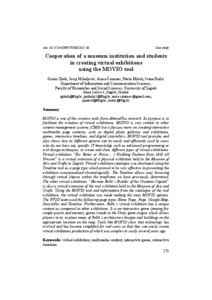Zlodi, Goran and Mihaljević, Josip and Šimunec, Anica and Mikeli, Paula and Rudić, Ivana.
(2015).
Cooperation of a museum institution and students in creating virtual exhibitions using the MOVIO tool.
In: 5th International Conference "The Future of Information Sciences, INFuture2015: e-Institutions – Openness, Accessibility, and Preservation", 11-13 November 2015, Zagreb.
Abstract
MOVIO is one of the creative tools from AthenaPlus network. Its purpose is to facilitate the creation of virtual exhibitions. MOVIO is very similar to other content management systems (CMS) but it focuses more on creating interactive multimedia page contents, such as digital photo galleries and exhibitions, games, interactive timelines, and digital storytellers. MOVIO tool provides and also shows how its different options can be easily and efficiently used by users who do not have any specific IT knowledge such as advanced programming or web design techniques, to create and show different types of virtual exhibitions. Virtual exhibition “For Better or Worse… / Wedding Fashion from 1865 till Present” is a virtual extension of a physical exhibition held in the Museum of Arts and Crafts in Zagreb. Virtual exhibition catalogue was developed using the Timeline tool as a page type which proved to be very effective in presenting the exhibition conceptualized chronologically. The Timeline allows easy browsing through virtual objects within the timeframe we have previously determined. The other virtual exhibition, “Herman Bollé – Builder of the Croatian Capital” is also a virtual extension of the real exhibition held in the Museum of Arts and Crafts. Using the MOVIO tool and information from the catalogue of the real exhibition, the virtual exhibition was made making the most MOVIO options. The FFZG team used the following page types Home Page, Page, Google Map, Storyteller and Timeline. Furthermore, Bolle’s virtual exhibition has a unique content as compared to other exhibitions. It is an interactive game (among few simple puzzle and memory games) made in the Unity game engine which allows players to try to place many of Bollé’s architecture designs and buildings on the appropriate location on the map. Tools like MOVIO show that technology has evolved and has become simplified for end users so that they can easily create virtual exhibitions production of which was complex or costly several years ago.
Actions (login required)
 |
View Item |
![[img]](http://darhiv.ffzg.unizg.hr/8346/1.hassmallThumbnailVersion/2015/images/papers/7-03%20Zlodi%20et%20al.%2C%20Creating%20virtual%20exhibitions%20using%20MOVIO%20tool.pdf)



 Statistics
Statistics Statistics
Statistics
